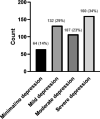Depression and opinion of dental students regarding the hybrid learning model during the COVID-19 pandemic
- PMID: 37060098
- PMCID: PMC10103031
- DOI: 10.1186/s40359-023-01157-8
Depression and opinion of dental students regarding the hybrid learning model during the COVID-19 pandemic
Abstract
Background: The global spread of COVID-19 forced schools at all educational levels to close, which was repeated in more than 60 countries. In addition, the COVID-19 pandemic has affected the mental health of dental students world wide. This study hypothesizes that the prevalence of depression in dental students from El Salvador is higher than that reported in studies from Europe, Asia, and North America.
Methods: This study was an online cross-sectional survey performed at the Faculty of Dentistry of the University of Salvador. The PHQ-9 questionnaire was applied to know the level of depression of the students, and a questionnaire focused on learning the opinion of the students on the hybrid teaching model adopted. Approximately 450 students participated in both questionnaires.
Results: Regarding the levels of depression present in the students, 14% had minimal depression, 29% had medium depression, 23% had moderate depression and, 34% had severe depression. The students had an excellent opinion regarding the hybrid learning model.
Conclusions: The prevalence of depression in dental students in El Salvador seems to be higher than that reported in studies in non-Latin American countries. Therefore, universities must generate care plans for mental health to avoid these harmful effects on students during future contingencies.
Keywords: COVID-19; Dental students; Depression; Epidemiology; Pandemics; Prevalence.
© 2023. The Author(s).
Conflict of interest statement
I declare that the authors have no competing interests as defined by BMC or other interests that might be perceived to influence the results and discussion reported in this paper.
Figures
Similar articles
-
Prevalence and correlates of depression and anxiety among Chinese international students in US colleges during the COVID-19 pandemic: A cross-sectional study.PLoS One. 2022 Apr 14;17(4):e0267081. doi: 10.1371/journal.pone.0267081. eCollection 2022. PLoS One. 2022. PMID: 35421199 Free PMC article.
-
Undergraduate dental students' perspective of online learning and their physical and mental health during COVID-19 pandemic.PLoS One. 2022 Jun 16;17(6):e0270091. doi: 10.1371/journal.pone.0270091. eCollection 2022. PLoS One. 2022. PMID: 35709435 Free PMC article.
-
The perspective of undergraduate dental students on web-based learning in pediatric dentistry during the COVID-19 pandemic: a Korean multicenter cross-sectional survey.BMC Med Educ. 2021 Sep 25;21(1):505. doi: 10.1186/s12909-021-02928-w. BMC Med Educ. 2021. PMID: 34563185 Free PMC article.
-
Impact of COVID-19 pandemic on the mental health of university students in the United Arab Emirates: a cross-sectional study.BMC Psychol. 2022 Dec 16;10(1):312. doi: 10.1186/s40359-022-00986-3. BMC Psychol. 2022. PMID: 36527101 Free PMC article.
-
Prevalence of Anxiety in Dental Students during the COVID-19 Outbreak: A Meta-Analysis.Int J Environ Res Public Health. 2021 Oct 19;18(20):10978. doi: 10.3390/ijerph182010978. Int J Environ Res Public Health. 2021. PMID: 34682726 Free PMC article. Review.
Cited by
-
The evolution of medical education in the era of Covid-19 and beyond: a longitudinal study.BMC Med Educ. 2024 Nov 11;24(1):1289. doi: 10.1186/s12909-024-06271-8. BMC Med Educ. 2024. PMID: 39529071 Free PMC article.
-
Depression and academic engagement among college students: the role of sense of security and psychological impact of COVID-19.Front Public Health. 2023 Aug 4;11:1230142. doi: 10.3389/fpubh.2023.1230142. eCollection 2023. Front Public Health. 2023. PMID: 37601170 Free PMC article.
References
-
- WHO, Global. El Salvador [Internet]. WHO. Global: El Salvador. [citado 22 de julio de 2022]. Disponible en: https://covid19.who.int/region/amro/country/sv
MeSH terms
LinkOut - more resources
Full Text Sources
Medical


